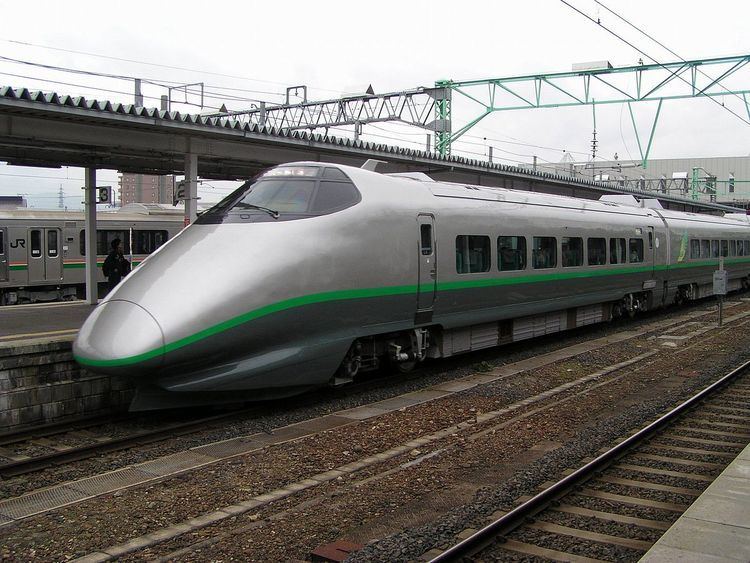In service July 1992 – April 2010 Constructed 1992–1995 Scrapped 2008–2010 | Refurbishment 1999–2001 | |
 | ||
Manufacturer Hitachi, Kawasaki Heavy Industries, Tokyu Car Corporation | ||
The 400 series (400系) was a Japanese Shinkansen high-speed train type operated by East Japan Railway Company (JR East) between 1992 and 2010 on Tsubasa services on Japan's first mini-shinkansen line, the Yamagata Shinkansen branch from the main Tohoku Shinkansen.
Contents
The fleet of 400 series trains was leased by JR East from the owning company, Yamagata JR Chokutsū Tokkyū Hoyū Kikō (山形ジェイアール直通特急保有機構(株)), a third-sector company jointly owned by JR East and Yamagata Prefecture.
They were originally six-car sets, but a seventh car (type 429) was added in 1995 to each set due to the popularity of the new Tsubasa services.
Pre-series set
The pre-series set, S4, was delivered in October 1990, and shown off to the press on 26 October 1990. This was a six-car set arranged as shown below with all cars motored.
The unit featured three different types of bolsterless bogies: DT9028 on cars 1 and 3, DT9029 on cars 2 and 4, and DT9030 on cars 5 and 6. The Green car seats featured seat-back TV screens, a feature not used on the subsequent production sets.
Test running began on the Ōu Main Line between Niwasaka and Itaya on 14 November 1990. From 23 January 1991, test running began in conjunction with a newly converted 200 series 8-car K set on the Tōhoku Shinkansen between Sendai and Kitakami. On 26 March 1991, the 400 series set S4 established a new Japanese speed record of 336 km/h on the Jōetsu Shinkansen in the Yuzawa Tunnel between Echigo-Yuzawa and Urasa. On 19 September 1991, the train set a new speed record of 345 km/h on the same stretch of track.
Test running continued into 1992, with set S4 reaching Tokyo for the first time on 20 May 1992. The pre-series set was then modified to bring it up to production batch standards, becoming set L1 on 29 June 1992.
Formation
The production 400 series sets were configured as shown below following the addition of a trailer car (car 15) in late 1995.
Cars 1 and 2 were built by Tokyu Car Corporation, cars 3 to 4 were built by Hitachi, and cars 5 to 6 were built by Kawasaki Heavy Industries. Cars 12 and 14 were equipped with pantographs.
Fleet details
Source:
Exterior
Styling wise, the 400 series were originally painted a medium silver grey with a darker roof and area around the cab windows and underframe, but they were refurbished and repainted between 1999 and 2001, with a higher area of dark bluish-grey on the underside, coming up almost to the side windows, and separated from the silver grey with a green stripe. The dark grey on the roof and around the cab windows was removed.
Clearances were much reduced compared to previous Shinkansen lines, and thus the 400 series units were much narrower than previous Shinkansen trains. At shinkansen stations (i.e. high-speed line stations), steps extended from beneath the doors to bridge the gap between the trains and platforms.
Interior
Green (first class) car accommodation had with 2+1 abreast seating, unlike the E3 series trains which replaced them, which featured 2+2 seating in both standard and Green cars. Seat pitch was 1,160 mm (46 in) in Green class (car 11), 980 mm (39 in) in reserved-seating cars (12 to 15), and 910 mm (36 in) in non-reserved cars (16 and 17).
When the fleet received life-extension refurbishment between 1999 and 2001, the interiors were also refurbished with new seat moquette. The reserved seating cars received red moquette, while the non-reserved seating cars received turquoise moquette.
Introduction
The fleet of 12 six-car sets entered service on the new Tsubasa shinkansen services from 1 July 1992. The six-car sets were all lengthened to seven cars between November and December 1995 with the addition of a new type 429 trailer car as car 15.
Withdrawal
Withdrawals started in December 2008, with the first set, L1. The entire fleet was scheduled to be withdrawn by summer 2009 and replaced by new E3-2000 series trains. However, one set, L3, remained in service until 18 April 2010, with the date chosen to mark 18 years of service.
Preservation
The first eleven sets to be withdrawn were all cut up at Sendai General Depot, but one car (Green car 411-3) of the last set to be withdrawn, L3, remains stored at a location in Fukushima pending possible future preservation.
